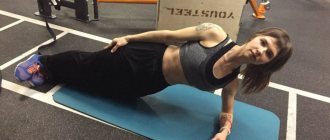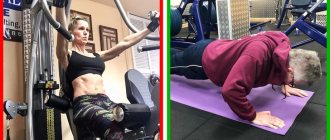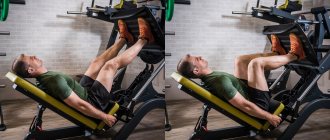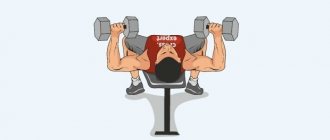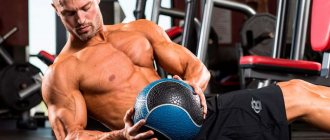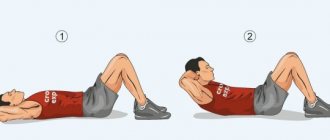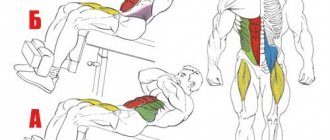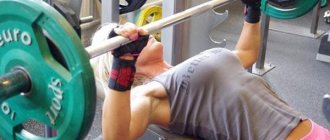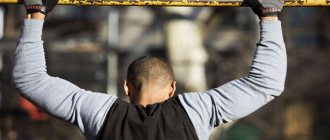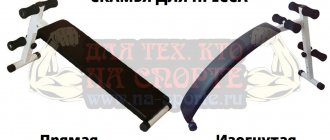I think we should start with the benefits of strengthening your abdominal muscles. For many, doing abdominal exercises is a means of getting six-pack and ripped. But not many people know that strong abs are the basis of a healthy spine, along with the lower back and core muscles. Therefore, abdominal exercises are necessary for absolutely all athletes, regardless of their goal - relief or weight gain. The main thing is strengthening the abdominal muscles correctly and safely for the spine, and thickening the cubes or fat burning depends on other factors. Next, we will consider the types and techniques of twisting, recommendations for performing exercises for each goal.
Benefits of crunch exercise
The main advantage of the exercise that sets it apart from others is its safety. The fact is that when twisting, the abdominal muscles contract as much as possible without putting stress on the spine or other joints. Perhaps this is the safest, technically simplest and most understandable exercise. There are more complex versions of the exercise, but they should be performed by trained athletes.
This exercise strengthens the rectus abdominis muscle, which is a spinal stabilizer muscle.
Another benefit is improved blood circulation in the abdominal cavity and massage of internal organs.
Do spinal flexions cause disc damage?
A variety of research methods are used to study spinal biomechanics and its impact on disc pathophysiology, including in vivo
and
in vitro
in humans and animals, as well as in silico computational models (63). In particular, thanks to in vitro experiments, it was shown that flexion of the spine is the main mechanism for the formation of disc herniation (protrusion of the disc substance beyond the ring) and prolapse (protrusion of the nucleus pulposus through the fibrous ring), since, according to the results, the pathological process is a gradual migration the nuclei outward, in the posterolateral direction - the weakest point of the ring (62).
(30, 35, 36, 70, 123). The model includes installation of the vertebral motion segment in a special device, with a constant compression force, which is combined with dynamic flexion and extension. The total number of flexion cycles ranged from 4,400 to 86,400, with a compression load of about 1,500 N. According to Axler and McGill (13), the “basic” twist variations have a compression force of about 2,000 N, which is the basis for comparison. In each of the studies, the majority of discs had small or significant herniations, predominantly in the posterior part of the annulus. This confirms the cause-and-effect relationship between disc injuries and spinal flexion. The research results are summarized in the table.
The results of studies of the biomechanics of the spine in vivo reflecting the influence of compression forces when performing twists
| Study | Spine type | Number of objects | Compression amount, N | The number of cycles | Number of hernias |
| Callaghan and McGill (30) | Pig neck | 26 | 260 -1472 | 86400 | 15 |
| Drake et al. (35) | Pig neck | 9 | 1472 | 6000 | 7 |
| Tampier et al. (123) | Pig neck | 16 | 1472 | 4400 — 14000 | 8 |
| Drake and Callaghan (36) | Pig neck | 8 | 1500 | 10000 | 8 |
| Marshall and McGill (70) | Pig neck | 10 | 1500 | 6000 | 4 |
Although the above studies show the potential risk of repetitive spinal flexion, several studies have attempted to extrapolate findings from the laboratory to the gym. The first and most important thing is in experiments studying the problem in vitro
, moreover, with removed muscles, it is impossible to reproduce the
in vivo
that occurs during normal movements of the human spine (98, 141 - 143, 147). Like all living tissues, vertebrae and their supporting structures undergo remodeling following stress (24). According to Wolff's and Davis's laws, tissue deformation leads to an increase in cell matrix stiffness, which helps resist subsequent deformation (102, 103). The vertebrae and intervertebral discs are no exception, as they strengthen in response to gradually increasing exercise loads (2, 24, 66, 92). Tissues of deceased people lose their ability to remodel.
Another important point when interpreting the results of invivtro
with cyclic loads of the spine, the natural flow of fluid is stopped. According to Van der Veen et al. (132), in the porcine lumbar spine, fluid outflow occurred under load, but no inflow was observed during unloading, thus reducing the height of the disc, which distorted its normal biomechanics.
In vitro examination
further complicated by the use of animal models. Although structurally similar to the human spine (146, 29), particularly the porcine cervical and human lumbar spine, there are many anatomical and physiological variations (130). In particular, in flexion experiments, the absolute range of motion in pigs is smaller than in humans (10). These important differences may reduce the practical significance of the findings regarding dynamic spinal flexion exercises in humans.
Moreover, the study was designed to replicate workers' loading patterns by subjecting a spinal segment to thousands of cycles of flexion, far beyond what is typically performed in dynamic exercise programs. A typical core strengthening session involves a limited number of dynamic repetitions and the trainee rests after completing the set. some time before making the next trip. Thus, the total number of curls per workout is small compared to what is reported in the studies, and the load cycles are performed intermittently rather than continuously. Rodacki et al. (97) found that despite the moderate compression associated with traditional crunches, the transient nature of the load (short-term spinal compression) did not cause fluid loss. In fact, abdominal crunches have an advantage over the Fowler's position in terms of unloading the back, presumably mediated by greater fluid drainage than the static supine position (97).
It should also be noted that after performing the exercises, the spinal tissues have the opportunity to recover before the next training session. This reduces the load on the disc and gives the structures time to remodel. Damage is caused by the exercise when the fatigue damage exceeds the level of adaptive remodeling. This depends on the intensity of the load, its sharp increase, the age and health of the trainee (2). Provided that dynamic spinal exercises are performed in compliance with the individual disc loading capacity, positive adaptation of the surrounding tissues is observed. In support of this claim, Videman et al. (136) found that moderate physical activity was least pathological compared with extreme levels of activity or inactivity.
Finally, the role of genetics must be taken into account. Although it is generally believed that spinal degeneration is most often caused by wear and tear from mechanical loading, this factor plays a small role in this process (17). It has been shown that 74% of cases are due to heredity (15). Battie et al. (17) identified specific forms of genes associated with disc degeneration that accelerate spinal degenerative changes in the absence of repetitive trauma. Inherited factors, such as the size and shape of spinal structures, as well as the biochemical constituents that build or destroy the disc, can strongly influence disc pathology, along with the interaction of genotype and environment (17).
In a case-control study of 45 male monozygotic twin pairs, Battie et al. (16) showed that subjects who spent 5 times more time driving and performed at least 1.7 times more lifting did not exhibit greater disc degeneration compared with their siblings and, although not statistically significant, showed even slightly smaller lumbar disc herniations. Varlotta et al. (133) also concluded that the relative risk of lumbar disc herniation in subjects under 21 years of age is approximately 5 times higher with a “positive” family history. Moreover, physically active people suffer less from back pain than sedentary people (44, 78).
Additionally, studies do not necessarily replicate spinal movements similar to lumbar flexion exercises. For example, traditional crunches involve bending the torso approximately 300 degrees at the expense of the spine, provided that only the head and shoulders are lifted from the floor, and the thoracic region is flexed predominantly (105, 117). Adams and Hutton (6) showed that with a difference in lumbar flexion of 20 to 110 instead of 130, resistance to flexion motion is reduced by 50%, which means a 50% reduction in flexion stress to the annulus and intervertebral ligaments. Thus, the region and degree of flexion have a significant influence on the movement of the spine.
In conclusion, the compressive forces generated during exercise due to muscle contraction also increase intra-abdominal pressure (IAP) (32). A three-dimensional biomechanical model shows a reduction in compressive force of approximately 18% when IAP is taken into account for spinal flexion forces (118). Thus, IAP produced by flexion exercises may reduce compressive forces, helping to unload the spine and facilitate fluid absorption by the discs (97). Since in vitro models to date do not include IAP, this limits the conclusions regarding the safety of crunches. However, the unloading effect of IAP may be reduced by high levels of coactivation during abdominal muscle contraction (12). More research is needed, focusing specifically on the effect of IAP on compressive forces in people performing flexion exercises, including crunches.
It is also worth noting some epidemiological studies showing an increased risk of spinal injury in athletes whose training requires repetitive flexion of the spine. Spinal column injuries, including disc degeneration and herniation, occur most frequently in gymnasts, rowers, and soccer players (120, 122, 135, 144). Moreover, elite athletes are more likely to be injured than low-level athletes (88, 120). However, the dose-response relationship between spinal flexion and injury in these athletes has not been established, and the ballistic nature of such athletic activity is practically unsuitable for controlled dynamic abdominal exercises.
What muscles work during abdominal crunches?
For crunches, the target muscle is the rectus abdominis, mostly the middle and upper part. But it is a mistake to consider this exercise for the so-called upper abs. Since the rectus abdominis muscle is only conditionally divided into parts, this does not mean that its lower part is completely disabled. On the contrary, the lower abdomen also strengthens, but the characteristic burning sensation is caused by twisting in the upper part.
Also auxiliary muscles are:
- Oblique abdominal muscles.
- Sternocleidomastoid.
- Serratus anterior muscles.
- Rhomboid muscles.
- Lower part of the trapezius muscle.
What can you do instead of crunches?
Conventional twisting can be replaced with similar actions using different devices:
- twisting from the upper block;
- on an inclined bench;
- in a Roman chair;
- on the simulator.
There are several options for how you can diversify this exercise.
Hand position: You can place them behind your head, on your chest, and you can also use your hands to support additional weight (behind your head or on your chest, as you wish).
The position of the legs can also be changed: for starters, it is better to put them on a chair, sofa, bench. To create constant abdominal tension, your legs need to be held at an angle. Medium difficulty option - legs raised vertically.
Which version of the starting position is right for you must be determined based on your physical fitness. But don’t try to immediately grab the most difficult variation of crunches, as you will only harm your body.
Technique for performing variants of straight twists while lying on the floor
Straight crunches
- Lie down on the mat.
- Bend your knees and place your feet on the floor.
- Place your hands behind your head.
- Press your lower back firmly into the floor and do not lift it during the entire approach.
- As you exhale, twist your torso, lifting your chest off the floor, but only to your lower back; your lower back should not lift off the floor.
- At the top of the twist, contract your muscles as much as possible and hold for a second.
- As you inhale, slowly lower yourself onto the mat and repeat the crunches.
- When lifting up, do not help with your hands, do not touch your chin to your collarbones and do not bring your elbows to the center.
- Try to look up, aiming your chin at the ceiling.
Straight crunches with legs raised
This is a more difficult variation compared to the previous one, since the abdominal muscles are constantly tense due to keeping the legs suspended. You can hold both straight legs vertically and bent, it all depends on the elasticity of the muscles and ligaments, this does not affect the technique.
- Lie on the floor, pressing your lower back to the floor, lift your legs up, keeping them in one position.
- You can hold your hands behind your head or stretch them forward. Another option is to reach your palms towards your toes.
- Exhale and twist your body without lifting your lower back from the floor, keeping your chin hanging and looking up.
- At the top point, pause a little.
- As you inhale, smoothly return down, but do not lower your shoulders to the floor, thereby maintaining tension in the muscle.
- Repeat the crunches, keeping your legs as motionless as possible, and most importantly, do not arch your lower back; for this, your abs should always be tense.
Double crunches
A more complex version of the exercise that is suitable for physically fit people. The difficulty of the exercise lies in the simultaneous twisting of both the upper torso and the pelvis. In this case, the lower abs, which do not seem to work in straight crunches, begin to be actively involved in the exercise along with the upper and middle rectus muscles.
- Lie on the floor, put your hands behind your head, and lift your legs up, bending your knees at right angles.
- As you exhale, simultaneously perform an overhead twist as usual and twist your pelvis, bringing your knees closer to your chin.
- When twisting the pelvis, do not try to lift the pelvis up or twist the lower back too much; here it is important to contract the rectus muscle while pushing the chest closer to the knees.
- Exhale and return to the starting position without lowering your legs and shoulders to the floor, maintaining tension in your muscles at all times.
Straight crunches with weights
This option is used only by trained athletes who have fully mastered the above options. At the moment when the load becomes insufficient, there is no burning sensation and fatigue with repeated repetitions, then you should add a load in the form of plates for a barbell or dumbbells. In this case, a pancake or dumbbell can be held on the chest with your arms crossed on it, or held suspended on straight arms.
- Lie on the floor and take the necessary weight, starting with the minimum load weight.
- Place your feet on the floor; in the future, this option can be complicated by keeping your legs suspended.
- As in the previous variations, twist your upper torso without lifting your lower back off the floor.
- Breathing and technique remain the same, it is also important not to sink to the floor all the way, maintaining tension.
How to do it right?
Classic crunches are a partial lifting of the torso from a lying position. In this case, your hands can be either placed behind your head or extended in front of you (simplified variation). During the exercise, the middle and lower back should be constantly pressed to the floor.
Starting position: lying on your back, legs bent at the knees and firmly on the floor. By activating your abdominal muscles, smoothly lift your shoulders 10-15 cm, rounding your back and twisting towards your knees. Hold for 1-2 seconds, then slowly lower your body, but do not touch your shoulders to the floor.
// How to do crunches:
- 3 sets of 15-25 reps
- slow pace of execution
- breath control
Technology errors
If after twisting your neck or lower back hurts, this is a direct signal that the technique is broken. In most cases, crunches are performed either at too high a body angle (almost 90 degrees) or at an excessively fast speed.
The main signal of correct execution of crunches is the appearance of a characteristic burning sensation and feeling of fatigue in the rectus abdominis muscle - especially in its upper part. For beginners, 10-12 repetitions of the exercise may be enough to achieve this burn, while an advanced level of crunches involves at least 25 repetitions and the use of additional weight.
How to do crunches correctly: recommendations for women and men
At the initial stage of training, regardless of gender, it is necessary to perform crunches from 15 to 25 repetitions. This amount develops and strengthens muscles without overload, gradually adapting muscle fibers to a specific load. It is enough to perform 2-3 approaches. Then you can add weights and complicate it with other exercises and techniques.
Remember, if you work on the relief, that is, on the cubes, the main task will be to reduce adipose tissue, and this can be achieved not by the number of repetitions or abdominal exercises, but by a competent diet. Therefore, if the goal is to lose weight, then train as indicated above, while watching your diet. If the goal is to gain muscle mass, usually in men, then perform the exercise with a load of 6-12 repetitions of 3-4 sets.
Remember , the abs cannot be trained every day. The abdominal muscles, like others, need proper rest. And to get six-pack, it’s not how you train your abs that matters, but how and what you eat. Read more about nutrition for drying abs →
Crunches with legs up
Involves the entire surface of the rectus abdominis muscle. To increase efficiency, you can use additional weight in the form of a disk (pancake), which you need to grab the chest area with crossed arms.
How to perform
It is best to keep your legs straight during the exercise, but if you cannot straighten them, you can bend them slightly at the knees.
Position: lying down. Legs raised, arms - arms extended upward, lying along the body or crossed in a lock at the back of the head (whichever is more convenient). The lower back is pressed tightly to the mat. Slowly lift your torso towards your straight legs (if your arms are extended upward, then you should try to reach your toes with your fingers). Gently lower your torso and arms onto the fitness mat.
Do the twisting as you exhale, and as you inhale, return to the starting position.
Lateral (oblique) twists
This exercise allows you to pump up your oblique muscles well.
Execution order:
- We lie down on the floor, bend our legs and turn to the left.
- We place our right hand behind our head. We place our left hand on the stomach closer to the right side.
- We exhale and, tensing the right oblique muscles, try to reach the right elbow to the right knee.
- At the extreme point, we pause for a second and return to the starting position.
This will work on the right side. Next, you will need to perform similar steps, only on the other side, in order to pump up the left oblique muscles.
The one who walks can conquer the mountain!
Crunches bring great benefits not only to the muscles, but to the entire body. For a beginning athlete, the main thing is to figure out whether he can do such exercises before going to the gym or exercising at home. In the presence of dangerous diseases, an innocent desire to get in good shape can end very badly.
Don’t forget that abdominal exercises alone won’t do it. To avoid imbalance, it is necessary to work out other muscle groups. First of all, together with the abdominal muscles, you need to pump your back so that your torso develops harmoniously.
All types of twisting must be done smoothly and without jerking, tensing the abs as much as possible. Only in this case will you soon be able to see the result.

